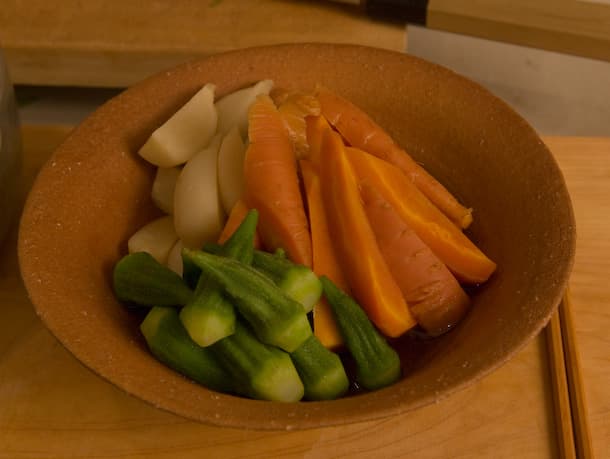
Turnips, Carrots and Okra Simmered in Dashi
Experience the flavors of fresh okra, carrots, and Japanese turnips simmered in dashi with a touch of usukuchi shoyu in this natural and delightful Japanese vegetable dish. Read about Atsushi's approach to preserving the natural flavors of vegetables and how to prepare this beautifully plated, delicate, and flavorful dish.
When Atsushi and I visited New York's Union Square farmers market together we found lovely okra as well as fresh carrots and white Japanese turnips (kabu). I asked Atsushi to prepare a simple dish to bring out their natural, peak-of-season flavors, so he decided to simmer them in dashi, and add a touch of usukuchi shoyu to give the vegetables a little saltiness. Usukuchi soy sauce is the light colored soy sauce of the Kyoto and Osaka region -- it's light colored, but actually saltier than the darker, more common koikuchi shoyu. (Because it's lighter colored, too, it doesn't overpower the hue of the dashi.)
Atsushi used three carrots, three turnips and a handful of small whole okra simmered in about two cups of dashi (see this recipe for a discussion about dashi). He scrubbed the roots well but didn't peel them. "The Nakahigashi style is all natural," said Atsushi. He explained that most of the flavor of vegetables is found right under the skin. If you peel the skin, you'll lose that flavor. "Many chefs peel all the flavor away."
The technique: For the okra, trim the caps, but don't rub off the hair, in keeping with Atsushi's natural philosophy. Bring a pot of salted water to a boil and cook the okra until they're tender, about five minutes. Rinse them under cold running water and set them aside.
While the okra is cooking, cut the kabu into quarters lengthwise, through the stem, leaving an aesthetically pleasing little nub of bright green stem on the white pieces For the carrots, cut them "lan giri" style: Cut the carrot on an angle, turn, cut on another angle, turn, cut on an angle, turn, cut on an angle, and so forth.
(When Atsushi cooked this dish again, he also added black radishes (or black daikon) cut in quarters lengthwise, which were wonderful, too.)
Bring the dashi to a boil and add the kabu and cook for five minutes. Now add the carrots and simmer on a low boil until the carrots are tender, another few minutes or so (test them). As soon as the carrots are looking ready, add the okra to heat through. Now turn off the heat and add about a tablespoon of usukuchi shoyu. Taste the broth. It should have a light shoyu taste. Most of the flavor should be from the sweetness of the vegetables, balanced by the dashi.
Atsuhi plated this dish in a bowl by arranging all the kabu in one pile, all the carrots in one pile and all the okra in one pile. He drizzled some broth and the dish was ready. It looked beautiful and the vegetables tasted amazing, delicate and flavorful. We had leftovers, so I can report that the vegetables and broth taste fantastic cold, too.
When you try this dish, I'd be grateful if you could let me know in the comments how it turns out. Did it work? Any questions or thoughts?
